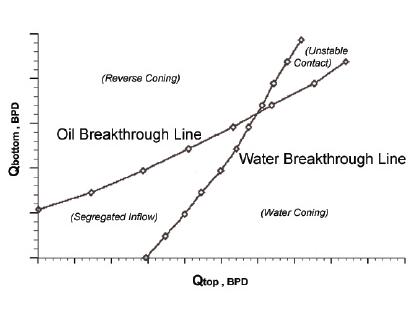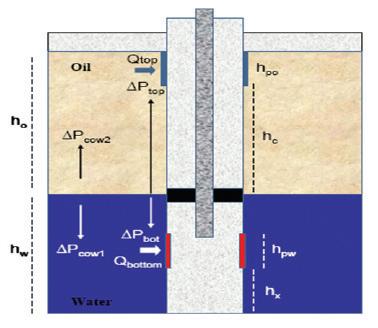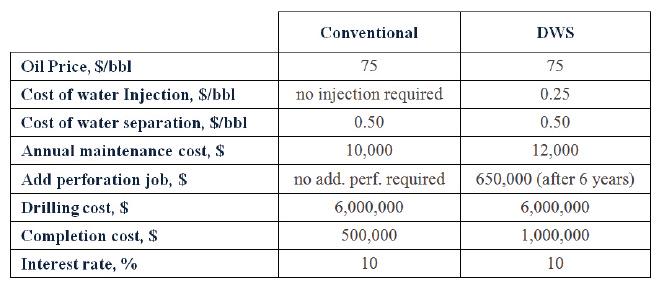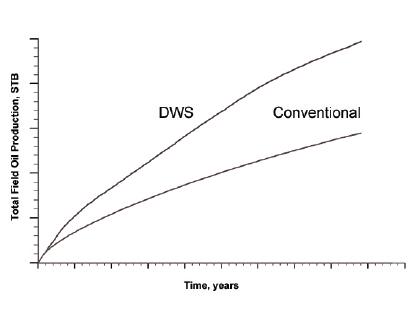
8 minute read
Developing Oil Fields with Down-Hole Water Sink Technique
Developing Oil Fields with Down-Hole Water Sink (DWS) Technique
Advertisement
Young talented creati ve minds are the main artery that feeds the success of any industry, the inexhausti ble spring of innovati on that keeps the world rapidly growing and spinning around us, here at this magazine we are trying to be the beacon that shades the light on those minds.
20 March 2011 ECHO Amr A. Essa Teaching Assisstant School of Sciences and Engineering American University in Cairo; AUC
INTRODUCTION
Water coning is one of the most criti - cal problems that occur in many oil fi elds. Water coning is usually caused by large drawdown in the oil bearing zones where the reservoir has acti ve bott om water drive.
The conventi onal method that is used to prevent or delay water coning is completi ng the upper secti on of the pay zone in questi on and producing with a rate below the criti cal rate. However, producing oil below its criti cal rate has proven to be not economical. Luckily, alternati ve methods have been investi gated by many authors such as down-hole water sink (DWS) completi on. The DWS primary mechanism is done by giving an adversary drawdown pressure in the oil zone and producing the water separately from the water zone as a dual completi on confi gurati on (above and below the oil water contact). Moreover, the drawdown pressure created in the water would allow higher oil producti on rate. The success key of DWS is a segregated fl ow in which only oil is produced from the top perforati on and only water is produced from bott om perforati on. So a stable oil water contact can be maintained throughout the producti on life. On the other hand, successful applicati on of DWS requires massive water producti on which consumes the reservoir energy and cause severe pressure drop. In this arti cle, economical feasibility study is done on developing oil fi elds with DWS technique. Additi onal costs of dual completi on, water handling, maintenance; necessity of water injecti on to maintain the reservoir pressure, etc, is compared to the profi t gained from higher producti on rate and higher recovery. The fi nal objecti ve is to decide how eff ecti ve is the DWS technique and when it is recommended to use it, i.e., to put the criteria for using this technique. The study is done on a simulati on model of chosen sector in Balaiem marine oil fi eldZone 2. Simulati on model is built using Schlumberger’s Eclipse 100 simulator.
DOWN HOLE WATER SINK COMPLETION (DWS)
This method uses a dual completi on confi gurati on (above and below the oil water contact). In this confi gurati on the well secti on above OWC is completed in the oil bearing zone and produces oil, while the well secti on below OWC is completed in the water saturated zone which serves as a drain to control the rise of the water cone. Schemati c comparison between the conventi onal completi on (single completi on) and the DWS completi on is shown in Fig.1 which illustrates one of the DWS completi on types that can accommodate the separated fl ow of oil and water, producing oil from the top perforati on through annulus and producing
Fig. 1
Coning control is performed by adjusting water production rate to oil production rate in order to prevent the water cone from breaking through the oil into the oil perforations. Physically, water perforations alter the flow potential field around the well so that at each point, the upward vertical component of viscous force generated by the flow into the upper perforations is reduced by the value of the downward vertical component of the second viscous force generated by the flow into the lower perforations. At equilibrium, a stable water cone is maintained around and below the oil producing perforations. The result is that the water cone is suppressed and oil water contact is stabilized. Fig.2. The purpose of this study is to evaluate the coning control potential of this method, as well as to compare its performance to the conventional method of oil production under the conditions of bottom water drive. Mathematical simulation is used to predict the method’s performance.
Performance of Down Hole Water Sink
The performance can be understood by the inflow performance relationship (IPW) Fig.3. It is a plot of water drainage from the bottom perforations verses oil production from the top perforations. The area inside the IPW defines production schedules for segregated inflows of oil and water into the well. The areas above the IPW define production schedules for reversed coning i.e. oil breakthrough into the water drainage completion. The areas below the IPW define production schedules for water breakthrough to the oil completion. For example, consider a well in which water drainage from bottom perforation is equal to zero (equivalent to conventional completion). From the IPW, this well can produce oil from top perforations with maximum flow rate of 58 bbl/day which is critical rate. Above this value, water cone begins to form and the production is in the water coning area. If water is drained from bottom perforations with a flow rate of about 400 bbl/day, water cone will be suppressed and well can produce oil with higher rate of about 90 bbl/day without water coning. Higher water drainage from water sink would allow even higher production rate of oil. However, this is limited where very high water drainage would cause reverse coning. IPW is generated using simulation models.


Fig. 2
There are several potential advantages of this method: (1) Oil production rate increases without water breakthrough. (2) Well life extends far beyond its value without coning control. (3) Oil recovery per well (and for the whole reservoir) increases due to the following mechanisms:
A. Production can be continued with high levels of static OWC (caused by the bottom water drive invasion), even when this level reaches the oil perforations B. Well productivity will be highbecause the near-well zone permeability to oil is not reduced by water encroachment. (4) Produced water will not be contaminated with crude oil, deemulsifiers and other agents used in oil production. Therefore, it will more likely meet effluent discharge limitations imposed by the environmental regulations in the area. (5) The water/oil ratio will be reduced with the new method.
Fig. 3
Optimization of Down Hole Water Sink
Down water sink can be considered as active mechanism to control water coning. Using this technique, we can have almost a total control over the water cone. However, successful application of DWS requires massive water production which consumes the reservoir energy and causes severe pressure drop. So water injection becomes necessary. All these factors and some other represent additional costs to the operator; therefore the process must be optimized to achieve effective and economical operation.
The following are the factors that affect (DWS) performance: (1) Perforations Locations. (2) Perforation Thicknesses. (3) Oil and Water Flow Rates.
This secti on describes the results of economical feasibility study on developing oil fi eld with down water sink technology. Additi onal costs of dual completi on, water handling, maintenance; necessity of water injecti on to maintain the reservoir pressure, etc, is compared to the profi t gained from higher producti on rate and higher recovery from applicati on of DWS. Finally we can decide how eff ecti ve is the DWS technique and when it is recommended to use it i.e. to put the criteria of using this technique. The study is done on a simulati on model of chosen sector in Balaiem marine oil fi eld-Zone 2. Simulati on model is built using Schlumberger Eclipse 100 simulator.
Runs Descripti on
Evaluati on of DWS is done according to the following scenario: Wells (in both completi ons) are controlled to produce maximum available producti on with 0% water cut. Water from bottom perforati on is re-injected into the formati on to maintain the pressure. The questi on which arises is “Does the profi t gained from higher recovery cover the cost of DWS and make additi onal profi t?” Results are discussed in the next secti on. A fact has to be menti oned here that wells don’t operate at zero water cut in reality. This fact doesn’t aff ect the result of the study because at any given value of water cut, the producti on rate using DWS will remain higher.
Results
Simulati on is run for 25 years with two producers & two injectors. Initi al producti on rate for conventi onal and DWS completi ons was 500 bbl/day and 1000 bbl/day respecti vely, producti on rate is reduced progressively by the simulator to maintain zero water cut. Generally, producti on rate in case of DWS is twice as that of conventi onal completi on. Total fi eld oil producti on was 12,223,897 bbl, 6,142,783 bbl for DWS and conventi onal completi on respecti vely.

Given the informati on in Table 1: Fig. 4 and Fig. 5 show respecti vely how the wells’ oil producti on rate and total fi eld oil producti on varies with ti me depending on whether the completi on technique is conventi onal or DWS.

Fig. 4
Fig. 5

According to this result, developing such fi elds using DWS is strongly recommended as it can increase the ulti mate recovery and/or accelerate the producti on. Producti on accelerati on can be of great importance especially in fi eld with related risk issues.
Table. 1
Aft er the simulator run, results were summarized in Table 2:

However, it should always be remembered that the story is no more than opti mizati on process, the main objecti ve is to achieve the best performance and the most economical. Therefore, this result is not applicable to all fi elds as it may be uneconomical in other fi elds. The fi rst criteria for DWS applicati on are high pressure reservoirs with acti ve water drive.








